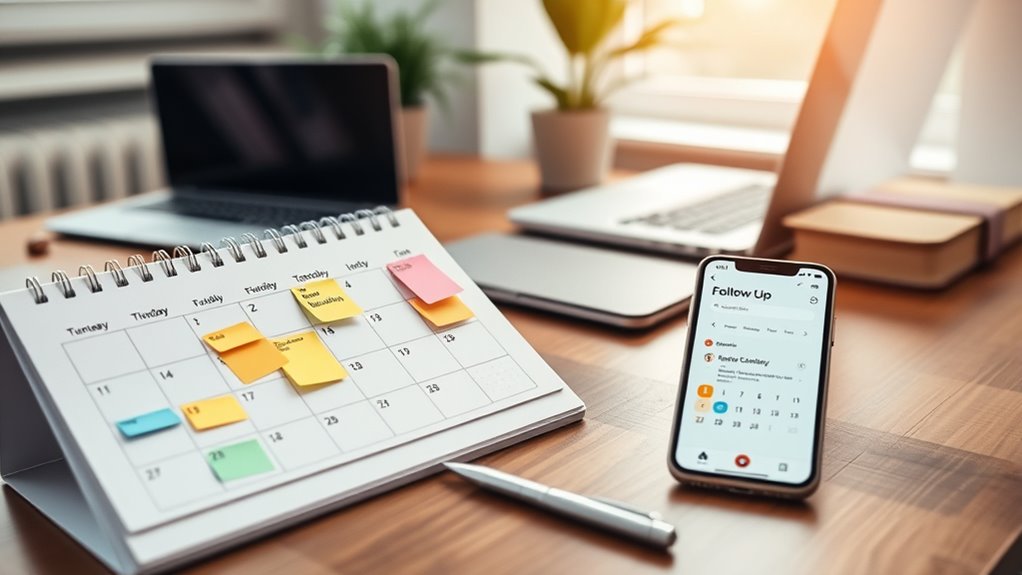The frequency of reaching out to past customers depends on your industry, the complexity of your offerings, and their purchase cycle. Generally, start with a thank-you or check-in within a few days after sale, then follow up every few weeks or months. Adjust based on how engaged your customers are and their needs. Maintaining consistent, personalized contact builds loyalty and trust—continue exploring more strategies to keep your customer relationships thriving.
Key Takeaways
- Follow up within a few days post-purchase to thank customers and confirm satisfaction.
- Schedule regular check-ins every few weeks or months based on the sales cycle.
- Adjust follow-up frequency according to product complexity and customer engagement levels.
- Personalize communication to strengthen relationships and demonstrate understanding of customer needs.
- Balance persistence with respect to avoid customer annoyance and maintain trust.

Have you ever wondered why a well-planned follow-up schedule is essential for achieving your goals? The truth is, consistent follow-ups are the backbone of maintaining strong customer relationships and boosting your sales. When you know exactly how often to reach out to past customers, you increase your chances of customer retention and sales conversion. Without a clear plan, you risk losing touch, which can lead to missed opportunities and declining business. A strategic follow-up schedule helps you stay top-of-mind, demonstrating your commitment to your customers’ needs and showing that you value their business even after the initial sale. This ongoing communication builds trust, encourages loyalty, and ultimately increases the likelihood that customers will return or recommend you to others.
How often you reach out depends on several factors, including your industry, the type of product or service, and your customer’s purchasing cycle. For example, if you sell high-value items or services that require a longer decision-making process, you might need to follow up more carefully over an extended period. Conversely, for quick, transactional sales, shorter intervals may be more effective. Typically, a good rule of thumb is to follow up within a few days after the initial purchase to thank your customer and address any questions. From there, you might schedule additional check-ins every few weeks or months, depending on your sales cycle. The key is to strike a balance—be persistent enough to stay relevant but not so pushy that you annoy or overwhelm your customers. Incorporating regular safety checks on your products can also help maintain customer trust and satisfaction.
Having a structured follow-up schedule also allows you to personalize your outreach. When you know the timing of your follow-ups, you can tailor your messaging to match your customer’s journey, making your communication more meaningful. This personalization helps foster customer retention because it shows that you understand their needs and are attentive to their experience. Additionally, consistent follow-ups can turn initial sales into long-term relationships, increasing sales conversion rates over time. Customers are more likely to buy from you again if they feel valued and appreciated, which a strategic follow-up plan supports.
Personalized follow-ups strengthen customer relationships and turn sales into lasting partnerships.
Ultimately, a well-crafted follow-up schedule is a proactive way to nurture your customer relationships and grow your business. It’s about maintaining regular touchpoints that reinforce your reliability and dedication. When you stick to a consistent plan, you not only improve customer retention but also create more opportunities for sales conversion. By understanding how often to reach out and sticking to that rhythm, you position yourself for sustained success, turning one-time buyers into loyal clients who keep coming back.
Frequently Asked Questions
What Tools Can I Use to Automate Follow-Ups?
You can use tools like HubSpot, Salesforce, or Mailchimp to automate follow-ups. These platforms offer CRM integration, making it easy to track customer interactions. Plus, they provide email templates that you can personalize for your follow-up messages. By setting up automated sequences, you save time and ensure consistent communication, helping you stay engaged with past customers without manual effort.
How Do I Personalize Follow-Up Messages Effectively?
To personalize follow-up messages effectively, focus on customer segmentation to group clients by interests or behaviors. Use this data to craft message customization that resonates with each group. Address customers by their name, reference their previous purchases, and include relevant offers or content. This tailored approach shows you value their individual needs, increasing engagement and strengthening your relationship. Consistent personalization makes your follow-ups more compelling and memorable.
Should I Vary Follow-Up Frequency by Customer Type?
Imagine your customer base as a garden, each plant needing different care. Yes, you should vary follow-up frequency by customer segmentation, tailoring personalized timing to fit their needs. Some customers crave frequent updates, while others prefer a gentle touch. By understanding these differences, you nurture stronger relationships, increase engagement, and boost loyalty. Customizing your outreach makes your follow-ups feel less like chores and more like meaningful conversations.
How Do I Handle Unresponsive Past Customers?
When handling unresponsive past customers, you should segment them based on their behavior and preferences. Adjust your follow-up timing accordingly—try spacing out messages or offering new incentives. If they remain unresponsive after a few attempts, consider a personalized message or a different communication channel. Regularly reviewing customer segmentation helps you identify the best follow-up timing, increasing your chances of re-engaging those customers effectively.
What Metrics Indicate Successful Follow-Up Strategies?
You’ll know your follow-up strategy is successful when customer retention improves and engagement rates rise. Track metrics like response rates, repeat purchases, and feedback quality. Keep an eye on follow-up timing—timely contact increases chances of reconnecting. If your customers respond positively and continue doing business with you, it indicates your follow-up timing and approach are effective, strengthening long-term relationships and driving growth.
Conclusion
Sticking to a consistent follow-up schedule shows your customers you care and keeps your business top of mind. For example, imagine a small coffee shop that checks in with customers a week after their first visit—many return, feeling valued and appreciated. By reaching out at the right times, you build trust and loyalty, turning one-time buyers into lifelong fans. Don’t wait—your next loyal customer could be just a follow-up away.









